‘Kapada na latta va khaya bhatta fajitee maay hoti lay mothi
Kakhet lekaru, haatat jhadna, doi war shenaachi paati,
Mahya Bhimana maiy sonyane bharali oti.’
[No clothes to wear, neither food to eat, it was a huge fuzzy,
Child in arms, broom in hands, pot full of shit on head,
my Bhim (Ambedkar) has filled my sack with gold.]
—Kadubai Kharat, an Ambedkarite Bhimwani singer and poetess who sings
Ambedkar’s song while visiting people in their homes and bastis
(Translation: Suraj Yengde)
Introduction
As a result of the caste system in India and the discrimination towards Dalits, the Constitution recognised the Scheduled Castes and Scheduled Tribes (“SC/ST”) as a specific category. Such formation was necessary for the purpose of distributing benefits to the marginalised communities. However, the SC/ST category is not a homogenous category as recognized by Krishna Iyer J. in State of Kerala v. N. Thomas. Although grouped as Dalits, they occupy varying locations on the bottom rungs of the caste hierarchy; some being poorer and more discriminated than others; visible and invisible Dalits. As a result of which, there is an internal hierarchy among various Dalit groups (see here, here and here). But our Constitution overlooks the internal hierarchy and even our laws recognise the SC/ST category as a homogenous category [see Scheduled Caste and Scheduled Tribes (Prevention of Atrocities) Act, 1989 (“The PoA Act”)].
However, this is set to change. Recently the Supreme Court referred the question of sub-classification within particular classes of SC/ST category to a larger bench. This comes as a result of the current bench’s disagreement with the Court’s 2005 decision in E.V. Chinnaiah v. State of AP and Ors., which held that Scheduled Castes formed a homogenous class and there could not be any subdivision in the Scheduled Caste list. There have been enlightening discussions on such sub-classification within the context of reservations (see here and here). However, the following piece would highlight the need for the law to recognise hierarchical harassment and intra-group violence among the SC/ST category.
Unequal Intra-Group Relations
The discourse on the most “marginalised” Dalits have been either neglected or deliberately kept aside. To study and understand Dalits, one has to remember the hierarchy among them that leads to the practice of untouchability. In, The Radical Ambedkar, Chandraiah Gopani illustrates two different identities within the SC/ST category, that of “visible” Dalits and “invisible” Dalits where the invisibility refers to the marginalised among Dalits.[1] The practice of untouchability within these categories includes different forms of exclusion and exploitation. Dr. Anup Surendranath, in his thesis, mentions that the thread of untouchability running in varna’s in general, is replicated amongst the Dalits. Also, there appears to be an apparent consensus among Dalits with regard to the general features of the caste system, especially in matters relating to purity and impurity. This is further in line with Louis Dumont’s central idea that “rank in caste hierarchy defined in terms of purity and impurity is just as clear amongst untouchables as it is among the dominant castes.”
“Marginalised” Dalits have been denied entry in temples by their fellow SCs due to them being considered impure,[2] they have been forced to take different caste certificates because of the lack of understanding about their castes,[3] and the major caste groups among the SCs in Tamil Nadu practise untouchability and discrimination amongst themselves.[4] As Suraj Yengde notes on ‘castegories’ in his book, Caste Matters, “conservative Dalits” detest lower-caste/class Dalits and ostracise inter-caste and inter-subcaste couples and “token Dalits” use casteist slurs against Dalit leaders and discriminate against Dalits from lower sub-castes.[5]
While the studies mentioned above have broadly suggested the prevalence of the practice of untouchability and discrimination within the SC/ST category, the intensity and nature of these practices has not been documented with the same rigour. Crime records such as National Crime Records Bureau and National Campaign on Dalit Human Rights have also failed to record the harassment and discrimination occurring as a result of untouchability within the SC/ST category. This is more so because the documentation of untouchability and discrimination against Dalits is primarily seen through the lens of upper castes and not through fellow SCs.[6] Therefore, there are few instances that reveal such harassment and discrimination.
How should then the law, address discrimination and practices associated with untouchability being inflicted on “marginalised” Dalits by fellow SCs? Cases like denial of temple entry due to the notion of impurity can in general be addressed by the Protection of Civil Rights Act, 1955, which seeks to penalise untouchability but it has been inadequate (see here) at dealing with practices/discrimination associated with untouchability. Such practices/discrimination would then fall under the purview of the PoA Act. However, due to these practices being inflicted on “marginalised” Dalits by fellow SCs, the PoA Act, in the current form, won’t help here.
The Premise of the PoA Act
The closest that Indian law has come to address the problem of discrimination and atrocities against Dalits is the formulation of the PoA Act. But the premise of the PoA Act doesn’t allow it to be used against acts of discrimination/harassment/atrocity against “marginalised” Dalits by fellow Dalits. The PoA Act seeks to prevent the commission of offences of atrocities against the members of the Scheduled Castes and the Scheduled Tribes and to that end, it seeks to provide for the trial of such offences and for the relief and rehabilitation of the victims of such offences. However, the act rests on an assumption that, a person who is subjecting a member of the SC/ST category to any atrocity has to be a person other than a member of the SC/ST category (let’s call this the “assumption clause”).
Let us understand why this is necessary. The object and reasons of the Prevention of Atrocities Act state that when the members of the SC/ST category assert their rights and resist practices of untouchability, the vested interests try to cow them down and terrorise them. As a result, the members of the SC/ST category become victims of attacks by the vested interests. The statute, therefore, seeks to prevent the legal culmination of such interests—false convictions; those with power (upper castes) could implicate the members of the SC/ST category with the commission of atrocities laid out in the Act and get away with.
However, this assumption holds ground as long as we operate on the premise that the SC/ST category is a homogenous category. What would happen if the law were to ditch the homogenous recognition of the SC/ST category and instead accept its heterogenous nature? Two scenarios will emerge by the inclusion/exclusion of members of the same category from the ambit of punishment:
- If the members of the SC/ST category are included within the ambit of the Act, then those with power could implicate the commission of atrocities on the “powerless” members of the SC/ST category, which would fail the purpose of the Act;
- If the members of the SC/ST category are excluded from the Act, then the law fails to address situations such as the ones mentioned above (e.g., denial of temple entry).
If the law removes the assumption clause or expands its ambit to include the members of the SC/ST category, scenario i) of false implications of the commission of atrocities on the “powerless” members of the SC/ST category unfolds, and if the law doesn’t change the assumption clause, it overlooks the hierarchical harassment flowing through the SC/ST category.
Possible Solutions
It is important to note that with no documentation on the intensity and nature of discrimination on “marginalised” Dalits, treating the atrocities inflicted by upper-caste on the SC/ST category on the same plane as those by fellow SCs on “marginalised” Dalits is a problematic stance and should be avoided unless studies document the intensity and nature of such discrimination. But nonetheless, there could be possible solutions to address such discrimination.
It could be suggested that an exception clause for atrocities/harassments by fellow SCs upon “marginalised” Dalits be introduced in the PoA Act. However, such an exception clause will not serve as an answer to our problem. This is because such an exception clause would also have to counter the risk of opening the floodgates of scenario i); to prevent upper castes from implicating the commission of atrocities on members of the SC/ST category, the exception would have to carry a different set of assumptions which will inevitably carry a greater burden of proof than required presently. This would ultimately dilute protection in such cases. Understand that this burden of proof will be higher for classes that are “more backward”, the result of which would be that the less privileged members would be carrying a higher burden.
Would then, an anti-discrimination law serve our purpose here? An anti-discrimination law will surely prevent the SC/ST category from discrimination/atrocities that are covered by the PoA Act, but by widening its ambit to all members of all communities, it will also offer protection to the “marginalised” Dalits. Two questions will, however, still need consideration: (a) Could an anti-discrimination law minimise the requirement of an explicit clause granting protection against false convictions to a certain category? and (b) Will a general legislation prohibiting discrimination be enough to protect the interests of the ones that are subjected to harsher forms of discrimination within the SC/STs?
Conclusion
Untouchability brings with it added risks and disadvantages that result in harassment and discrimination. Therefore, even if one doesn’t treat inter-group atrocities and intra-group atrocities on the same plane, the risks and disadvantages associated with untouchability that exists within the SC/ST category have to be taken into account by the law. As Gopani notes,[7] that in all studies concerning untouchability, untouchables are more or less considered homogenous and studies have failed to document the practices of untouchability and discrimination among Dalits. Therefore, there is a pressing need for documentation of the nature and intensity of such discrimination and untouchability. Conversely, it would be apt to consider whether criminal law should be the instrument to address such a concern. It’s also important to bear in mind the limits of law in this regard; it cannot be fine-grained enough to be unenforceable.
The author would like to thank Shreyasi Singh for her assistance in the research.
[1] Chandraiah Gopani, ‘New Dalit Movements: An Ambedkarite Perspective’, in Suraj Yengde and Anand Teltumbde, eds, The Radical in Ambedkar: Critical Reflections (New Delhi: Penguin Random House India, 2018), pp. 181–200.
[2] Ibid, page 127
[3] Ibid, page 129
[4] Ibid, page 127
[5] Suraj Yengde, ‘Caste Matters’ (New Delhi: Penguin Random House India, 2019), pp. 98-108.
[6] Ibid
[7] Ibid, Pg 127








Your point of view caught my eye and was very interesting. Thanks. I have a question for you.
Thanks for sharing. I read many of your blog posts, cool, your blog is very good.